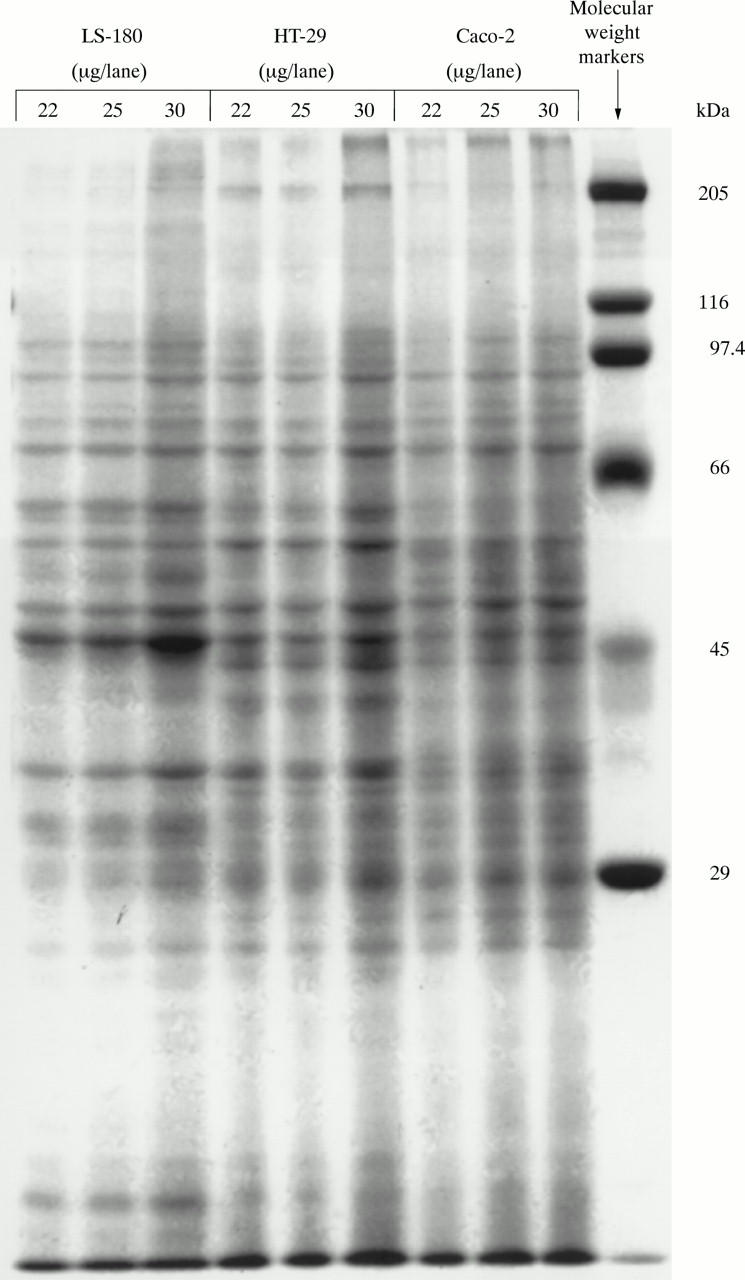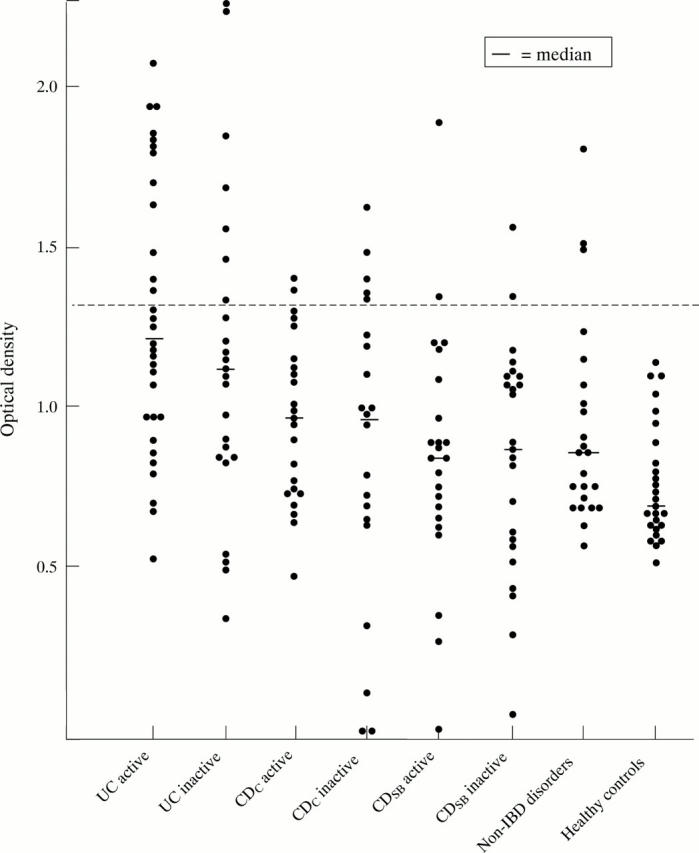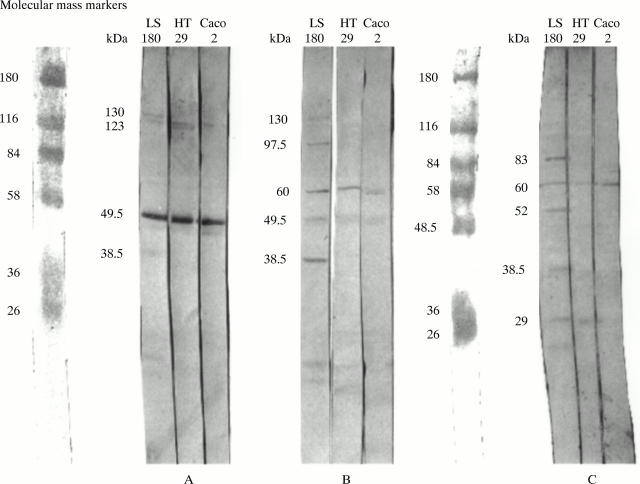Abstract
Background—Investigation of anti-colon antibodies may be simplified if a sensitive method and homogeneous source of antigen were available. Aims—To examine the anti-colon antibody response using human colonic carcinoma cell lines as antigen. Subjects—Patients with inflammatory bowel disease and other gastrointestinal disorders and healthy controls were studied. Methods—Comparative enzyme linked immunosorbent assays (ELISAs) were performed to assess the value of whole Caco-2, HT-29, and LS-180 cells as antigen. The antigenic determinants of the immune response were characterised by western blot analysis. Results—Sera demonstrated immunoreactivity against each of the cell lines, but different epitopes were recognised. Applying whole Caco-2 cells as antigen in an ELISA, the prevalence of anti-colon antibodies was significantly greater in patients with ulcerative colitis (36%) than Crohn's disease (13%), other gastrointestinal disorders (13%) and healthy controls (0) (p<0.05). The immune response was not associated with one predominant antigen. Conclusions—Fixed whole cell ELISA is a simple and feasible method for studying the anti-colon antibody response. This response is non-specific, being directed against multiple antigens, and is likely to be an epiphenomenon of inflammatory bowel disease, more so for ulcerative colitis than Crohn's disease.
Keywords: anti-colon antibodies; inflammatory bowel disease
Full Text
The Full Text of this article is available as a PDF (153.3 KB).
Figure 1 .

Protein profile of LS-180, HT-29 and Caco-2 cell homogenates separated by 5% stacking-10% separating polyacrylamide gels and stained with Coomassie blue. Bands corresponding to similar molecular masses are seen for each of the cells.
Figure 2 .
Examples of western blot analysis for sera from three patients with ulcerative colitis, (A) (B) and (C). Although the protein profiles of the cell lines are similar (see fig 1) and the nitrocellulose strips were incubated with the same serum sample, circulating antibodies did not recognise protein bands associated with all cells.
Figure 3 .

Scattergram of absorbance values obtained by ELISA using fixed whole Caco-2 cells as antigen to investigate the prevalence of anti-colon antibodies in patients with inflammatory bowel disease (IBD). Values above the dotted line are considered positive for anti-colon antibodies, representing results greater than three standard deviations above the mean of the healthy control group. CD, Crohn's disease; UC, ulcerative colitis.
Selected References
These references are in PubMed. This may not be the complete list of references from this article.
- Cantrell M., Prindiville T., Gershwin M. E. Autoantibodies to colonic cells and subcellular fractions in inflammatory bowel disease: do they exist? J Autoimmun. 1990 Jun;3(3):307–320. doi: 10.1016/0896-8411(90)90149-m. [DOI] [PubMed] [Google Scholar]
- Chapman R. W., Cottone M., Selby W. S., Shepherd H. A., Sherlock S., Jewell D. P. Serum autoantibodies, ulcerative colitis and primary sclerosing cholangitis. Gut. 1986 Jan;27(1):86–91. doi: 10.1136/gut.27.1.86. [DOI] [PMC free article] [PubMed] [Google Scholar]
- Das K. M., Dasgupta A., Mandal A., Geng X. Autoimmunity to cytoskeletal protein tropomyosin. A clue to the pathogenetic mechanism for ulcerative colitis. J Immunol. 1993 Mar 15;150(6):2487–2493. [PubMed] [Google Scholar]
- Fiocchi C., Roche J. K., Michener W. M. High prevalence of antibodies to intestinal epithelial antigens in patients with inflammatory bowel disease and their relatives. Ann Intern Med. 1989 May 15;110(10):786–794. doi: 10.7326/0003-4819-110-10-786. [DOI] [PubMed] [Google Scholar]
- Hamilton M. I., Bradley N. J., Srai S. K., Thrasivoulou C., Pounder R. E., Wakefield A. J. Autoimmunity in ulcerative colitis: tropomyosin is not the major antigenic determinant of the Das monoclonal antibody, 7E12H12. Clin Exp Immunol. 1995 Mar;99(3):404–411. doi: 10.1111/j.1365-2249.1995.tb05565.x. [DOI] [PMC free article] [PubMed] [Google Scholar]
- Harvey R. F., Bradshaw J. M. A simple index of Crohn's-disease activity. Lancet. 1980 Mar 8;1(8167):514–514. doi: 10.1016/s0140-6736(80)92767-1. [DOI] [PubMed] [Google Scholar]
- Hibi T., Ohara M., Kobayashi K., Brown W. R., Toda K., Takaishi H., Hosoda Y., Hayashi A., Iwao Y., Watanabe M. Enzyme linked immunosorbent assay (ELISA) and immunoprecipitation studies on anti-goblet cell antibody using a mucin producing cell line in patients with inflammatory bowel disease. Gut. 1994 Feb;35(2):224–230. doi: 10.1136/gut.35.2.224. [DOI] [PMC free article] [PubMed] [Google Scholar]
- Hibi T., Ohara M., Toda K., Hara A., Ogata H., Iwao Y., Watanabe N., Watanabe M., Hamada Y., Kobayashi K. In vitro anticolon antibody production by mucosal or peripheral blood lymphocytes from patients with ulcerative colitis. Gut. 1990 Dec;31(12):1371–1376. doi: 10.1136/gut.31.12.1371. [DOI] [PMC free article] [PubMed] [Google Scholar]
- Khoo U. Y., Bjarnason I., Donaghy A., Williams R., Macpherson A. Antibodies to colonic epithelial cells from the serum and colonic mucosal washings in ulcerative colitis. Gut. 1995 Jul;37(1):63–70. doi: 10.1136/gut.37.1.63. [DOI] [PMC free article] [PubMed] [Google Scholar]
- Laemmli U. K. Cleavage of structural proteins during the assembly of the head of bacteriophage T4. Nature. 1970 Aug 15;227(5259):680–685. doi: 10.1038/227680a0. [DOI] [PubMed] [Google Scholar]
- Lagercrantz R., Perlmann P., Hammarström S. Immunological studies in ulcerative colitis. V. Family studies. Gastroenterology. 1971 Mar;60(3):381–389. [PubMed] [Google Scholar]
- Marcussen H. Fluorescent anti-colonic and E. coli antibodies in ulcerative colitis. Scand J Gastroenterol. 1978;13(3):277–281. doi: 10.3109/00365527809179820. [DOI] [PubMed] [Google Scholar]
- Seibold F., Weber P., Klein R., Berg P. A., Wiedmann K. H. Clinical significance of antibodies against neutrophils in patients with inflammatory bowel disease and primary sclerosing cholangitis. Gut. 1992 May;33(5):657–662. doi: 10.1136/gut.33.5.657. [DOI] [PMC free article] [PubMed] [Google Scholar]
- Snook J. A., Lowes J. R., Wu K. C., Priddle J. D., Jewell D. P. Serum and tissue autoantibodies to colonic epithelium in ulcerative colitis. Gut. 1991 Feb;32(2):163–166. doi: 10.1136/gut.32.2.163. [DOI] [PMC free article] [PubMed] [Google Scholar]
- Snook J. A., de Silva H. J., Jewell D. P. The association of autoimmune disorders with inflammatory bowel disease. Q J Med. 1989 Sep;72(269):835–840. [PubMed] [Google Scholar]
- Sutherland L. R., Martin F., Greer S., Robinson M., Greenberger N., Saibil F., Martin T., Sparr J., Prokipchuk E., Borgen L. 5-Aminosalicylic acid enema in the treatment of distal ulcerative colitis, proctosigmoiditis, and proctitis. Gastroenterology. 1987 Jun;92(6):1894–1898. doi: 10.1016/0016-5085(87)90621-4. [DOI] [PubMed] [Google Scholar]
- Takahashi F., Das K. M. Isolation and characterization of a colonic autoantigen specifically recognized by colon tissue-bound immunoglobulin G from idiopathic ulcerative colitis. J Clin Invest. 1985 Jul;76(1):311–318. doi: 10.1172/JCI111963. [DOI] [PMC free article] [PubMed] [Google Scholar]
- Takahasi F., Shah H. S., Wise L. S., Das K. M. Circulating antibodies against human colonic extract enriched with a 40 kDa protein in patients with ulcerative colitis. Gut. 1990 Sep;31(9):1016–1020. doi: 10.1136/gut.31.9.1016. [DOI] [PMC free article] [PubMed] [Google Scholar]
- Towbin H., Staehelin T., Gordon J. Electrophoretic transfer of proteins from polyacrylamide gels to nitrocellulose sheets: procedure and some applications. Proc Natl Acad Sci U S A. 1979 Sep;76(9):4350–4354. doi: 10.1073/pnas.76.9.4350. [DOI] [PMC free article] [PubMed] [Google Scholar]



